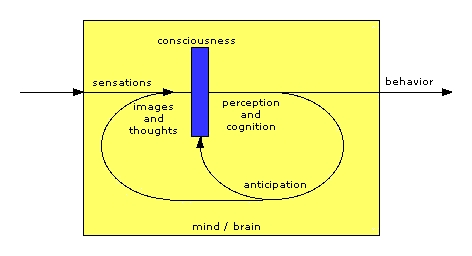
Images and Ideas
C. George Boeree
The current wisdom suggests that mental events such as images are
actions-in-the-making, or actions unrealized, or perceptual "searches."
We "draw" a unicorn in our minds by "looking" for a horse with a single
horn, etc. We "hear" a song in our minds by "listening" for
the notes, the sound of the instruments and the voices, the
words. This active, constructionist conception of images is often
connected with the idea of anticipation,* especially as Ulric Neisser
discussed it in Cognition and Reality or, earlier, George Kelly in his
books on Personal Construct Theory.
I agree that much -- perhaps most -- of our imagery is of this
nature. There are times, however, when images are experienced
more suddenly, in a brilliant flash even, than constructionism
implies. And, to take the opposite extreme, quite often we
anticipate in a more "generic" fashion, as when we anticipate a human
being -- any human being -- and not some specific one, that is to say
we anticipate with an idea more than with an image. The sudden
complete image and the generic idea require a somewhat richer
conception of anticipation.
Imagine that the signals coming from our sensory neurons are met by
neurons that have been "primed" by anticipation. That is, based
on the events of the prior moments of interaction between the neural
structures that are the result of our lifetime of learning, neurons or
neural nets are activated, and when the sensory circumstances that they
predict are confirmed by incoming sensory signals, these neurons or
neural nets pass that information deeper into, let us assume,
association cortex, where they lead to the next set of
anticipations. If the anticipations are not confirmed by incoming
sensory information (say within a certain time span), signals
indicating that non-confirmation are sent on to trigger new
anticipations that attempt to correct the mistaken anticipations (along
with actions and emotional experiences as well, one presumes). This
latter effect could be considered the basis of learning.
Now imagine a situation where we detach ourselves from incoming sensory
information: We are asleep and dreaming, perhaps, or have closed
our eyes or are staring at a blank page. We can nevertheless
generate anticipations, and set neurons or neural nets into that
anticipatory mode. But, instead of having them send signals only
when confirmed by sensory information, our new state allows these
anticipatory neurons to pass on their signals deeper into association
cortex without confirmation. They may even have further
repercussions by triggering new anticipations, actions, emotions, and
even learning.
In the usual perceptual interaction with the world, all the neurons
that a primed to receive incoming information from the senses at a
particular time could be considered our total anticipations for that
moment. In the restricted mode, retracted from interaction with
the senses, all the primed neurons would be an image or an idea.
Now consider the difference between ideas and images. Images may
be understood as the activity of anticipatory neurons nearer the
sensory end of our mental structure. A strong image is the
anticipation of a highly specific set of sensations. As far as
our deeper associative processes are concerned, what we are
experiencing is the meaning
of our anticipations without the substance
of them.
Given a "white" sensory field (white light or white noise, for
examples), strong image anticipation will select from that field the
expected qualities, giving us an iconic or echoic experience that, in
circumstances of
minimal or unusual information, could be mistaken for an actual
event. The complete or near-complete absence of sensory input
also gives a kind of empty surface to "project" image anticipations
onto. In the absence of actual sensory information to compare it
to, the image will be perceived as more-or-less vivid.
Ideas, on the other hand, reflect the activity of anticipatory neurons
deeper in the mind's structure which are the main ingredients of
imageless thought. The idea of "horse" may manifest itself at any
moment in the image of some particular horse, but need not.
Ideas should not, therefore, be confused with "fuzzy"
perceptions. Ideas are the "purer" meanings of our anticipations,
experienced at a greater distance from sensation.
To summarize, a constructive, anticipation-based understanding of
imagery and ideation need not rely solely on embodied or
action-oriented processes. Images and ideas can just as well be
understood as the activation of certain neural structures usually used
to anticipate sensory information.
*For a detailed description of possible mechanisms for anticipation,
please see Causes
and Reasons: The Mechanics of Anticipation.
©Copyright 2004 C. George
Boeree


